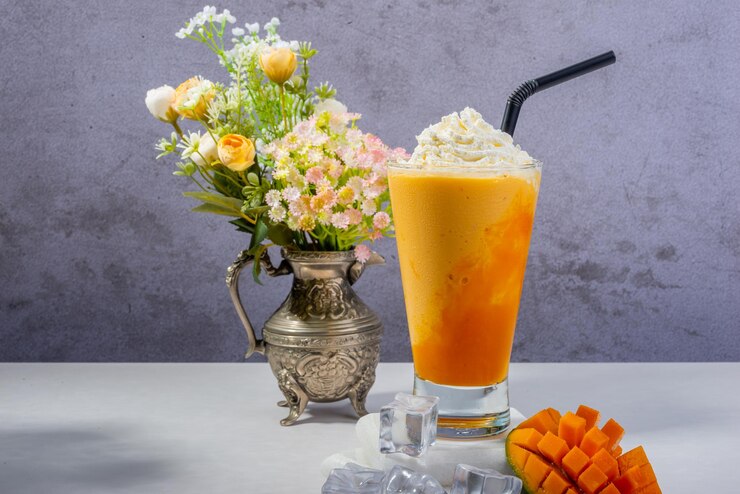Tropical smoothie have become a go-to option for anyone seeking a healthy, refreshing, and delicious treat. Whether you’re sipping one after a workout, enjoying it as a midday snack, or even using it as a meal replacement, tropical smoothies provide the perfect balance of nutrients, flavor, and hydration. Loaded with tropical fruits like mango, pineapple, and coconut, these smoothies offer a burst of sunshine in every sip. In this article, we will explore the world of tropical smoothies, their benefits, how to make them, and why they should be a part of your daily routine.
What is a Tropical Smoothie?
A tropical smoothie is a cold, blended drink made primarily from tropical fruits such as mango, pineapple, coconut, papaya, and banana. These fruits are often combined with other ingredients like yogurt, milk, plant-based milk, protein powders, seeds, and even leafy greens for added nutritional value. Tropical smoothies are famous for their creamy texture, sweet and tangy flavor, and vibrant colors.
These smoothies are not only refreshing but also packed with essential vitamins, minerals, and antioxidants that contribute to overall health.
Benefits of Drinking Tropical Smoothies
Incorporating tropical smoothies into your diet can offer a range of health benefits. Here are some key reasons why tropical smoothies are more than just a delicious drink:
1. Packed with Nutrients
Tropical fruits are rich in vitamins and minerals. Mangoes provide a hefty dose of vitamin C and vitamin A, while bananas are an excellent source of potassium. Pineapples contain bromelain, an enzyme that aids in digestion. By blending these fruits together, you create a nutrient-dense drink that supports overall health.
2. Excellent for Hydration
Tropical fruits like watermelon, coconut, and pineapple have high water content, making tropical smoothies a great way to stay hydrated, especially during hot weather. Adding coconut water or aloe vera juice can enhance hydration even further.
3. Supports Digestive Health
Many tropical fruits are rich in fiber, which helps to promote healthy digestion. Papayas contain papain, an enzyme known to break down proteins and aid digestion. Bananas and mangoes are also high in dietary fiber, helping to regulate bowel movements and support gut health.
4. Boosts Immunity
Tropical fruits, especially those rich in vitamin C like oranges, kiwi, and pineapples, are known to strengthen the immune system. Regular consumption of tropical smoothies can help protect your body from infections, colds, and other illnesses.
5. Helps with Weight Management
Tropical smoothies can be a great option for those looking to lose or maintain weight. They are naturally low in calories but high in fiber, which helps keep you feeling full longer. Plus, by avoiding sugary additives and focusing on whole fruits, you get a naturally sweet drink without the empty calories.
Best Tropical Fruits for Smoothies
The tropical fruit world is vast, offering a variety of flavors and textures that blend beautifully into smoothies. Below are some of the best tropical fruits to use in your smoothies:
1. Mango
Known for its rich sweetness and smooth texture, mango adds a creamy consistency to any smoothie. It’s also high in vitamin C and beta-carotene, both of which are beneficial for skin health.
2. Pineapple
With its tangy and slightly sweet flavor, pineapple brings a burst of freshness to smoothies. Its anti-inflammatory properties and digestive benefits make it a must-have ingredient.
3. Banana
Bananas are a staple in most smoothie recipes due to their ability to add natural sweetness and creaminess. They are also a great source of potassium, which helps in maintaining electrolyte balance.
4. Papaya
Papaya’s unique tropical flavor pairs well with citrus and other sweet fruits. It contains enzymes that aid digestion and is rich in antioxidants.
5. Coconut
Whether you use coconut milk, water, or meat, coconut adds a tropical flair to any smoothie. It’s a good source of healthy fats, which help keep you feeling full and satisfied.
6. Kiwi
Kiwi adds a tangy kick to your smoothie along with a ton of vitamin C and dietary fiber. Its bright green color also makes your smoothie visually appealing.
Tropical Smoothie Recipe
Making a tropical smoothie is easy and requires minimal ingredients and equipment. Here’s a basic recipe you can modify based on your preferences:
Basic Tropical Smoothie Recipe:
Ingredients:
- 1 cup mango (fresh or frozen)
- ½ cup pineapple (fresh or frozen)
- 1 banana
- ½ cup coconut water (or regular water/milk/plant-based milk)
- ¼ cup Greek yogurt (optional, for added creaminess and protein)
- 1 tablespoon chia seeds (for extra fiber)
- Ice cubes (optional)
Instructions:
- Add all the ingredients to a blender.
- Blend on high until smooth and creamy.
- If the smoothie is too thick, add more liquid (coconut water or regular water).
- Taste and adjust sweetness, adding honey or agave syrup if needed.
- Pour into a glass and enjoy!
Customizing Your Tropical Smoothie
One of the best things about tropical smoothies is how customizable they are. You can easily swap ingredients based on your preferences or dietary needs.
1. Add Greens
For an extra boost of vitamins and minerals, throw in a handful of spinach or kale. These leafy greens blend well with tropical fruits without overpowering the sweet flavors.
2. Boost Protein
To make your tropical smoothie more filling and suitable for meal replacement, consider adding a scoop of protein powder (whey, pea, or hemp), Greek yogurt, or even nut butter for added protein and healthy fats.
3. Superfood Add-Ins
For an extra health kick, try adding superfoods like chia seeds, flax seeds, spirulina, or maca powder. These ingredients provide additional nutrients, antioxidants, and fiber to your smoothie.
4. Sweeteners
If you prefer a sweeter smoothie, you can add natural sweeteners like honey, maple syrup, or agave nectar. However, tropical fruits are usually sweet enough on their own, so you might not need any extra sugar.
When is the Best Time to Drink Tropical Smoothies?
While tropical smoothies can be enjoyed at any time of the day, there are specific times when they offer even more benefits:
1. Post-Workout Recovery
After a workout, your body needs a combination of protein and carbohydrates to recover. A tropical smoothie with a scoop of protein powder and a blend of tropical fruits can replenish glycogen levels and support muscle recovery.
2. Breakfast
Tropical smoothies make an excellent breakfast option, especially for those who are always on the go. They provide essential nutrients that fuel your body and keep you energized throughout the morning.
3. Midday Snack
A tropical smoothie can be a refreshing midday snack that prevents you from reaching for less healthy options. The fiber content helps keep hunger at bay, while the natural sugars provide a quick energy boost.
Tropical Smoothie Bowls: A Fun Twist
If you’re looking for a new way to enjoy your tropical smoothie, consider making a tropical smoothie bowl. It’s essentially a thicker version of a smoothie served in a bowl and topped with various healthy ingredients like fresh fruit, granola, nuts, and seeds.
Tropical Smoothie Bowl Recipe:
Ingredients:
- 1 frozen banana
- 1 cup frozen mango
- ½ cup coconut milk
- Toppings: fresh kiwi, shredded coconut, chia seeds, granola, and sliced banana
Instructions:
- Blend the banana, mango, and coconut milk until thick and smooth.
- Pour the smoothie into a bowl.
- Add your desired toppings.
- Serve and enjoy with a spoon!
Conclusion
Tropical smoothies are a delicious and nutritious way to enjoy the vibrant flavors of the tropics while boosting your health. Packed with vitamins, minerals, and antioxidants, they can easily be adapted to fit your dietary needs and preferences. Whether you’re enjoying one for breakfast, post-workout recovery, or as a snack, tropical smoothies provide a refreshing and energizing option to fuel your day.
FAQs
1. Can I make tropical smoothies ahead of time?
Yes! You can prepare your tropical smoothie ingredients and store them in the freezer. When you’re ready to drink, just blend the ingredients with your preferred liquid.
2. Are tropical smoothies good for weight loss?
Tropical smoothies can be part of a weight-loss plan, especially if they’re made with whole, natural ingredients and used as a meal replacement or snack. Be mindful of added sugars or high-calorie ingredients.
3. Can I use frozen fruit for my tropical smoothie?
Absolutely! Frozen fruit works perfectly in tropical smoothies and often gives them a thicker, creamier texture. It’s also a great way to save money and ensure your fruit is ripe and ready when you need it.
4. What liquids should I use in a tropical smoothie?
Coconut water, coconut milk, almond milk, and regular water are all excellent choices. You can even use juice, though be mindful of added sugars in store-bought varieties.
5. Can tropical smoothies replace a meal?
Yes, especially if you add protein and healthy fats like Greek yogurt, protein powder, or nut butter. This makes the smoothie more filling and provides a balanced mix of nutrients.











